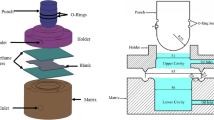Abstract
The workability diagram is often used for ductile fracture predictions in metal forming processes. Its determination requires the measurement of the strain to fracture in several tests in which the triaxiality ratio is supposed to be known and fixed throughout the process of deformation. One of such tests is the uniaxial tension test. In practice, however, it is very difficult (or even impossible) to keep the triaxiality ratio fixed in this test because of necking. It is shown in the present paper that the uniaxial tension test can be replaced with the collar test for obtaining a point of the workability diagram when the fracture criterion based on an average value of the triaxiality ratio is adopted. It is also shown that the collar test provides a more accurate prediction of the strain to fracture. The test carries out at quasi-static strain rates.

















Similar content being viewed by others
References
Atkins AG (1996) Fracture in forming. J Mater Process Technol 56:609–618
Marciniak Z, Duncan J (1992) Mechanics of sheet metal forming. Edwards Arnold, London
Vujović V, Shabaik A (1986) Workability criteria for ductile fracture. Trans ASME J Eng Mater Technol 108:245–249
Dieter G (2003) Bulk workability of metals. In: Dieter G, Kuhn H, Semiatin L (eds) Handbook of workability and process design. ASM International, pp 22–34
Shirgaokar M (2005) Flow stress and formability. In: Altan T, Nagaile G, Shen G (eds) Cold and hot forging. ASM International, pp 25–36
Reiss W, Pohlandt K (1986) The Rastegaev upset test – a method to compress large material volumes homogeneously. Exp Technique 10:20–24
Vujović V, Plančak M, Vilotić D (1994) The use of forming limit diagram in formability analysis. J Technol Plast 19:31–38
Vilotic D, Plancak M, Grbic S, Alexandrov S, Chikanova N (2003) An approach to determining the workability diagram based on upsetting tests. Fat Fract Eng Mater Struct 26:305–310
Vilotic D, Planchak M, Chupkovich D, Alexandrov S, Alexandrova N (2006) Free surface fracture in three upsetting tests. Exp Mech 46:115–120
Vilotic D, Alexandrov S, Plancak M, Movrin D, Ivanisevic A, Vilotic M (2011) Material formability at upsetting by V-shape dies. Steel Res Int Special Edition 923–928
Oyane M, Sato T, Okimoto K, Shima S (1980) Criteria for ductile fracture and their applications. J Mech Work Technol 4:65–81
Gouveia BPPA, Rodrigues JMC, Martins PAF (1996) Fracture prediction in bulk metal forming. Int J Mech Sci 38:361–372
Goijaerts AM, Govaert LE, Baaijens FPT (2000) Prediction of Ductile Fracture in Metal Blanking. Trans ASME J Manuf Sci Eng 122:476–483
Narayana Murty SVS, Nageswara RB, Kashyap BP (2004) Improved ductile fracture criterion for cold forming of spheroidised steel. J Mater Process Technol 147:94–101
MSC. SuperForm user’s guide, Version 2005
DEFORM Integrated 2D-3D version 10.1 user’s manual
Li H, Fu MW, Lu J, Yang H (2011) Ductile fracture: experiments and computations. Int J Plast 27:147–180
Kuhn HA (2003) Cold upset testing. In: Dieter G, Kuhn H, Semiatin L (eds) Handbook of workability and process design. ASM International, pp 57–60
Semiatin SL (2003) Workability in forging. In: Dieter G, Kuhn H, Semiatin L (eds) Handbook of workability and process design. ASM International, pp 188–207
El-Domiatty A (1999) Cold workability limits for carbon and alloyed steels. J Mater Eng Perform 8:171–183
Gouveia BPPA, Rodrigues JMC, Martins PAF (2000) Ductile fracture in metalworking: experimental and theoretical research. J Mater Process Technol 101:52–63
Tatting G, Antretter T, Pipan R (2007) Fracture of austenitic steel subjected to a wide range of stress triaxiality ratios and crack deformation modes. Eng Fract Mech 75:223–235
Behrens A, Just H (2002) Verification of the damage model of effective stresses in cold and warm forging operations by experimental testing and FE simulations. J Mater Process Technol 125–126:295–301
Sljapic A, Hartley P, Pillinger I (2002) Observations on fracture in axi-symmetric and three-dimensional cold upsetting of brass. J Mater Process Technol 125–126:267–274
Landre J, Pertence A, Cetlin PR, Rodrigues JMC, Martins PAF (2003) On the utilization of ductile fracture criteria in cold forging. Finite Elem Anal Des 39:175–186
Hoa VC, Seo DW, Lim JK (2005) Site of ductile fracture initiation in cold forging: a finite element model. Theor Appl Fract Mech 44:58–69
Shah JJ, Kuhn HA (1986) An empirical formula for workability limits in cold upsetting and bolt heading. J Appl Metalwork 4:255–261
Acknowledgment
The research described in this paper was supported by grant TR035020 from the Ministry of Science of Serbia. A part of this work was done while the first author was with National Chung Cheng University (Taiwan) as a research scholar under the recruitment program supported by the National Science Council of Taiwan (contact 99-2811-E-194-009). S.A. acknowledges support from the grant RFBR-11-08-91154 (Russia).
Author information
Authors and Affiliations
Corresponding author
Rights and permissions
About this article
Cite this article
Alexandrov, S., Vilotic, D., Konjovic, Z. et al. An Improved Experimental Method for Determining the Workability Diagram. Exp Mech 53, 699–711 (2013). https://doi.org/10.1007/s11340-012-9676-3
Received:
Accepted:
Published:
Issue Date:
DOI: https://doi.org/10.1007/s11340-012-9676-3




